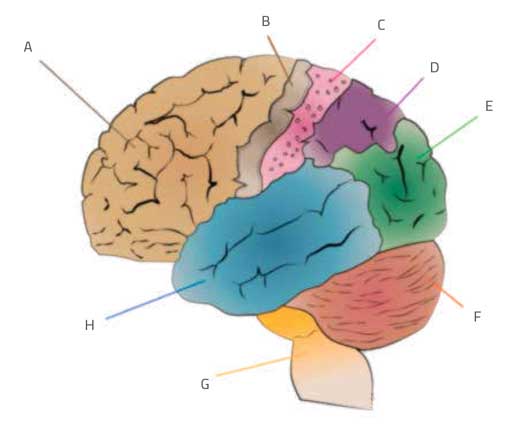How neuroscience is helping us to understand attention and memory Understand article
How electrodes placed directly in the brain are teaching us about learning.
“There is a war in our brains,” says neuroscientist Jean-Philippe Lachaux, research director at the French National Health Research Institute (Inserm) in Lyon, France. “It is a competition between the habit system, which allocates attention based on fixed rules and experience, the reward system, and the executive system, mainly located in the frontal lobe.”
When faced with multiple activities, these systems combine to produce a map of priorities. If you want to concentrate on writing a report, solving a puzzle, having a conversation or reading a long article, you want your executive system to win the war. But with so much external stimulation – from smart phones and noisy ringtones to TV shows and eye-catching billboards – it can be difficult to focus on your task.
Lachaux wants to figure out which neural networks within these brain systems react when we are distracted. A deeper understanding of what is going on when we lose concentration could help neuroscientists to train people to resist distraction.

Image courtesy of Jkwchui; image source: Wikimedia Commons
Much of the work in this area has been on ‘zoning out’ or mind-wandering. What Lachaux and his team are interested in, however, is ‘micro mind-wandering’: those brief flickers of distraction we experience when someone’s phone rings while we are doing a crossword puzzle. “With micro mind-wandering you don’t totally lose track but you experience interference,” said Lachaux. “For a couple of seconds, you are suddenly multitasking.”
At Lachaux’s lab in Lyon, they have a somewhat unorthodox approach – intracranial electroencephalogram (EEG). This technique involves an operation under general anaesthetic to place electrodes directly on the surface or deep within the brain of the patients. To use such an invasive technique for purely research purposes would, of course, raise serious ethical questions. Lachaux’s study, however, was performed on patients with epilepsy who – for therapeutic reasons unconnected with the study – were connected to intracranial EEG for two weeks. The subjects were asked to concentrate on performing a task on an iPad and then observing what happens when they are distracted, for example, by a ringing telephone.
The same distraction tests, minus the EEG, were carried out on a second, healthy group aged 6 to 60 years, to benchmark the study group’s performance and reveal how concentration varies with age.
“The first thing we noticed was that distractibility increases between the ages of 6 and 20, after which it is pretty stable through adulthood,” said Lachaux. “And, from the EEG group, we identified the areas implicated in these lapses of attention.”
Attention and learning

electroencephalogram
experiment, a helmet with
dozens of electrodes is
placed on top of the skull
surface.
Image courtesy of Csaba
Segesvári; image source:
Wikimedia Commons
Lachaux believes these kinds of insight will pave the way for powerful intervention programmes that can be used to improve children’s attention in schools. “Even simply explaining to children that different brain areas are competing to control their attention can help them to understand multitasking.”
Attention is important for learning as it plays a role in memory, and a wandering mind can affect your ability to recall information. For mundane things like recalling details from a report or a textbook that you read yesterday, this can be annoying or inefficient, forcing you to re-read material you would have remembered if you had not been distracted. But what about more emotionally extreme situations like witnessing a car accident or hearing a gunshot? Psychologists have been studying how emotion and stress affect our ability to concentrate and recall details.
Until recently, the consensus was that emotional stimuli consume so much of our cognitive resources that we forget other information we were receiving at the same time. The idea was that our brain was designed to focus on something emotional at the expense of other information.
However, Michiko Sakaki, a senior research fellow at the University of Reading, UK, says new findings from her research team suggest the reality may be more complex. “Arousal has different effects depending on priority. When people encounter emotional stimuli, it can enhance attention to particularly salient information to which we attach high priority.”
Sakaki has been conducting controlled experiments on the interaction between emotion and cognition. To induce an emotional response, subjects receive electrical stimulation – which is unpleasant but not dangerous – while a high- or low-pitch tone is played (Lee et al, 2014). They soon learn to associate the tone with the small electric shock. Then researchers ask participants to play a memory game while listening to the dreaded tone. The task requires participants to remember various items with different salience (for example: faces, which are intrinsically relevant to humans, and places). The question is then how well the subjects perform the memory task under the stress of fearing an electric shock.
“We found that participants’ attention is affected by emotion and priority, such that they pay more attention to particularly vivid information or details that are highly relevant to them, but their retention of low-priority information is impaired,” said Sakaki. Her team also found a similar pattern in participants’ memory.
“This calls into question the traditional view that emotional arousal always impairs processing of other information,” she said. “It is not so simple. Our notion that emotion enhances attention to, and retention of, high-priority information suggests that teachers could use positive emotional arousal in an educational setting to selectively enhance students’ learning.”
Acknowledgements
The original version of this article was published in Horizon, the EU research and innovation magazinew1.
References
- Lee TH et al (2014) Emotional arousal amplifies the effects of biased competition in the brain. Social Cognitive and Affective Neuroscience 9: 2067-2077. doi: 10.1093/scan/nsu015
Web References
- w1 – The original article can be read on the Horizon website.
Resources
- To find out more about educational neuroscience and its use in the classroom, read:
- Marytnoga B (2015) Can neuroscience solve the mystery of how students learn? The Guardian (UK), 12 July.
- For an example of using positive emotional stimulation in the classroom, see:
- Molyneux C (2007) Using music in the science classroom. Science in School 5: 32-35





